Three Perpendicular Lines Theorem
If two lines \( a \) and \( b \), perpendicular to a line \( r \), are drawn from a point \( P \) on \( r \), then \( r \) is perpendicular to any other line \( s \) that passes through \( P \) and lies in the plane \( \alpha \) formed by \( a \) and \( b \).
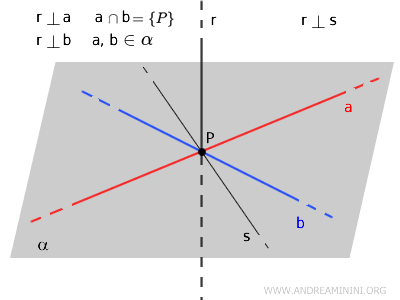
The three perpendicular lines theorem is particularly valuable in three-dimensional geometry for establishing orthogonality between lines and planes.
For example, it provides a straightforward way to verify if a line is perpendicular to another line or a plane by analyzing their relationships within the associated plane.
The Proof
Let’s start with a point \( P \) and a line \( r \).
Draw two lines \( a \) and \( b \), both perpendicular to \( r \), passing through \( P \).
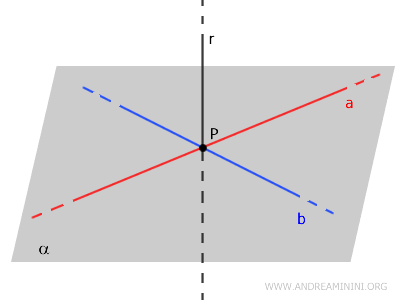
The lines \( a \) and \( b \) define the plane \( \alpha \), making them coplanar.
By construction, the lines \( a \) and \( b \) intersect at \( P \) and are both perpendicular to \( r \).
$$ a \cap b = \{ P \} $$
$$ a, b \in \alpha $$
$$ a , b \perp r $$
Thus, \( r \) is perpendicular to the plane \( \alpha \), and their intersection is limited to point \( P \).
$$ r \cap \alpha = \{ P \} $$
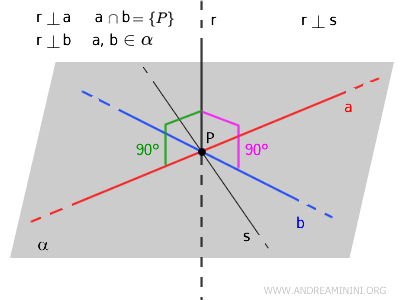
Now, choose two points \( Q \) and \( R \) on \( r \), equidistant from \( P \) on opposite sides of the plane \( \alpha \).
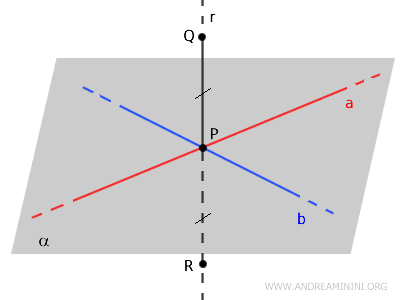
Since \( Q \) and \( R \) are equidistant from \( P \), the segments \( PQ \) and \( PR \) are congruent:
$$ PQ \cong PR $$
Next, draw a line \( s \) within the plane \( \alpha \).
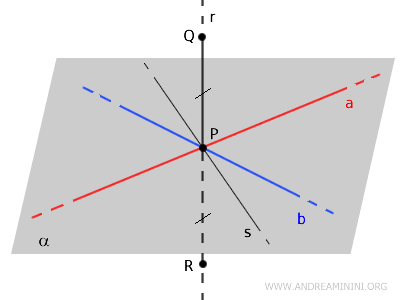
Select two points \( A \) and \( B \) on \( a \) and \( b \), respectively, and connect them with a segment \( AB \) that intersects \( s \) at \( T \).
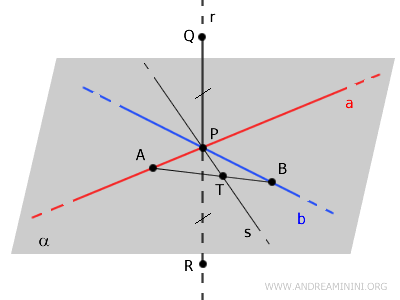
Draw segments \( AQ, TQ, BQ \) and \( AR, TR, BR \), forming several triangles.
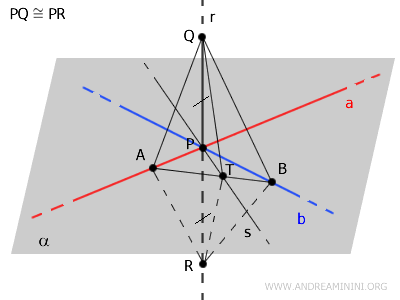
In \( \triangle AQR \), the segment \( AP \) acts as both the altitude and the median relative to the base \( QR \), since \( PQ \cong PR \).
This proves that \( \triangle AQR \) is an isosceles triangle, so \( AQ \cong AR \).
$$ PQ \cong PR $$
Similarly, \( \triangle BQR \) is isosceles because \( PB \) serves as both the altitude and the median relative to \( QR \).
Thus, \( BQ \cong BR \).
$$ BQ \cong BR $$
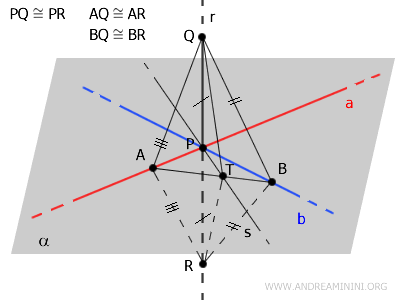
Now, consider triangles \( \triangle ABQ \) and \( \triangle ABR \).
According to the third congruence criterion, \( \triangle ABQ \cong \triangle ABR \), as they share the side \( AB \) and have two pairs of congruent sides: \( AQ \cong AR \) and \( BQ \cong BR \).
$$ ABQ \cong ABR $$
Since these triangles are congruent, their corresponding angles are equal.
Specifically, \( \angle ABQ \) and \( \angle ABR \) are congruent.
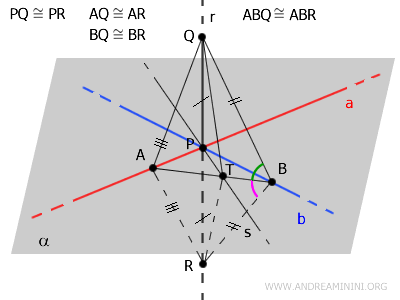
In triangles \( \triangle TBQ \) and \( \triangle TBR \), the side \( TB \) is shared, \( BQ \cong BR \), and the angles \( \angle ABQ \) and \( \angle ABR \) are congruent.
By the first congruence criterion, \( \triangle TBQ \cong \triangle TBR \).
$$ TBQ \cong TBR $$
Since \( \triangle TBQ \) and \( \triangle TBR \) are congruent, all their sides are equal.
In particular, \( TQ \cong TR \).
$$ TQ \cong TR $$
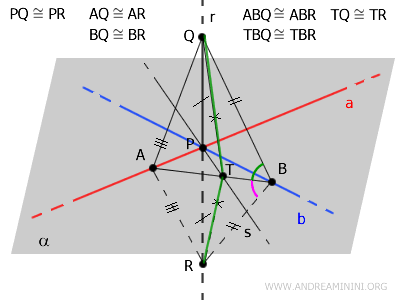
Knowing \( TQ \cong TR \), we can conclude that \( \triangle TQR \) is isosceles.
Thus, \( PT \) serves as both the altitude and the median of \( \triangle TQR \).
This establishes that \( PT \) is perpendicular to the base \( QR \), forming a \( 90^\circ \) angle.
$$ PT \perp QR $$
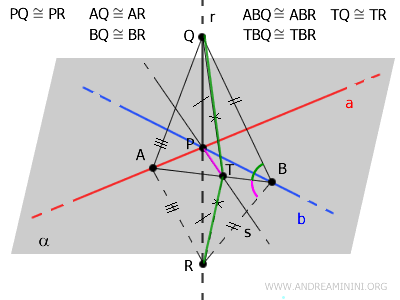
Finally, since \( QR \) lies on line \( r \) and \( PT \) lies on line \( s \), we conclude that lines \( r \) and \( s \) are perpendicular.
$$ r \perp s $$
The same reasoning applies to any line \( s \) within the plane \( \alpha \).

With this, the theorem is proven.
And so forth.
